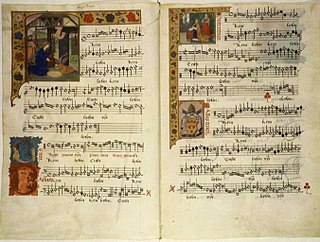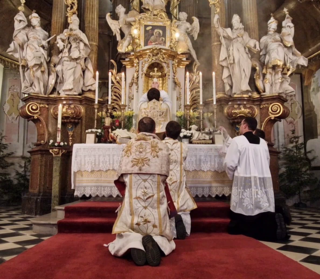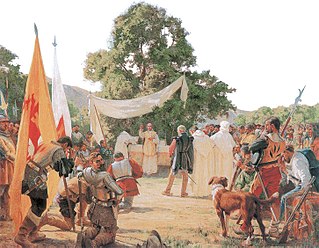
Missa cantata (Latin for "sung Mass") is a form of Tridentine Mass defined officially in 1960 as a sung Mass celebrated without sacred ministers, i.e., deacon and subdeacon. [1]

Missa cantata (Latin for "sung Mass") is a form of Tridentine Mass defined officially in 1960 as a sung Mass celebrated without sacred ministers, i.e., deacon and subdeacon. [1]
Documents of the Holy See such as the Decree of the Congregation of Sacred Rites of 14 March 1906 spoke of Missa cantata sine Ministris (Sung/Chanted Mass without the Ministers). The 19th-century Ceremonial for the Use of the Catholic Churches in the United States of America (commonly called the "Baltimore Ceremonial" because published by request of the Third Plenary Council of Baltimore of 1884) used the name: High Mass without Deacon or Sub-Deacon [2]
The Baltimore Ceremonial thus classified the Missa cantata as a High Mass. The early 20th-century Catholic Encyclopedia said, on the contrary, that a Missa cantata "is really a low Mass, since the essence of high Mass is not the music but the deacon and subdeacon. Only in churches which have no ordained person except one priest, and in which high Mass is thus impossible, is it allowed to celebrate the Mass (on Sundays and feasts) with most of the adornment borrowed from high Mass, with singing and (generally) with incense." [3]
In 1960, Pope John XXIII's Code of Rubrics distinguished the Missa cantata both from a high Mass and from low Mass. Under the number 271, it defined the forms of Mass as follows:
Masses are of two kinds: sung Masses (in cantu) and low Masses (Missa lecta).
A Mass is called a sung Mass, when the celebrant actually sings those parts which the rubrics require to be sung; otherwise it is called a low Mass.
Moreover, a sung Mass, when celebrated with the assistance of sacred ministers, is called a solemn or High Mass (Missa solemnis); when celebrated without sacred ministers, it is called a Missa cantata. [4]
The Missa cantata came into use during the 18th century and was intended for use in non-Catholic countries where the services of a deacon or a subdeacon (or clergy to fill these parts in the ceremony of the Mass) were not easily had. It was intended to be used in place of Solemn Mass on Sundays and major feast days.
The use of incense at a Missa cantata was at first forbidden, but became general: "The Sacred Congregation of Rites has on several occasions (9 June 1884; 7 December 1888) forbidden the use of incense at a Missa Cantata; nevertheless, exceptions have been made for several dioceses, and the custom of using it is now generally tolerated." [3] General permission was finally granted in the 1960 Code of Rubrics, which stated: "The incensations that are obligatory in Solemn Mass are permitted in every Missa Cantata". [5]
The parts sung by the priest are to be sung in Gregorian chant. More elaborate musical settings of the choir's parts may also be used. [6]
The rigid distinction between a sung Mass and a low Mass in the Roman Rite was abandoned in the 1969 revision of the Roman Missal. The General Instruction of the Roman Missal even states: "It is very appropriate that the priest sing those parts of the Eucharistic Prayer for which musical notation is provided." [7] Under the heading "The Importance of Singing", it says: "Great importance should therefore be attached to the use of singing in the celebration of the Mass, with due consideration for the culture of the people and abilities of each liturgical assembly. Although it is not always necessary (e.g., in weekday Masses) to sing all the texts that are of themselves meant to be sung, every care should be taken that singing by the ministers and the people is not absent in celebrations that occur on Sundays and on holy days of obligation." [8]

Mass is the main Eucharistic liturgical service in many forms of Western Christianity. The term Mass is commonly used in the Catholic Church, Western Rite Orthodoxy, Old Catholicism, and Independent Catholicism. The term is also used in some Lutheran churches, as well as in some Anglican churches, and on rare occasion by other Protestant churches.

The Mass of Paul VI, also known as the Ordinary Form or Novus Ordo, is the most commonly used liturgy in the Catholic Church. It was promulgated by Pope Paul VI in 1969 and its liturgical books were published in 1970; those books were then revised in 1975, they were revised again by Pope John Paul II in 2000, and a third revision was published in 2002.

The Tridentine Mass, also known as the Traditional Latin Mass or the Traditional Rite, is the liturgy in the Roman Missal of the Catholic Church codified in 1570 and published thereafter with amendments up to 1962. Celebrated almost exclusively in Ecclesiastical Latin, it was the most widely used Eucharistic liturgy in the world from its issuance in 1570 until the introduction of the Mass of Paul VI.

A Requiem or Requiem Mass, also known as Mass for the dead or Mass of the dead, is a Mass of the Catholic Church offered for the repose of the soul or souls of one or more deceased persons, using a particular form of the Roman Missal. It is usually celebrated in the context of a funeral.

The Mass is a form of sacred musical composition that sets the invariable portions of the Christian Eucharistic liturgy, known as the Mass.

A Pontifical High Mass, also called Solemn Pontifical Mass, is a Solemn or High Mass celebrated by a bishop using certain prescribed ceremonies. Although in modern English the word "pontifical" is almost exclusively associated with the pope, any bishop may be properly called a pontiff. Thus, the celebrant of a Pontifical High Mass may be the pope, any bishop or any other prelate who is allowed to wear pontificals.

An altar server is a lay assistant to a member of the clergy during a Christian liturgy. An altar server attends to supporting tasks at the altar such as fetching and carrying, ringing the altar bell, helping bring up the gifts, and bringing up the liturgical books, among other things. If young, the server is commonly called an altar boy or altar girl. In some Christian denominations, altar servers are known as acolytes.

The maniple is a liturgical vestment used primarily within the Latin Rite of the Catholic Church, and occasionally used by some Anglo-Catholic and Lutheran clergy. It is an embroidered band of silk or similar fabric that is hung over the left arm. It is only used within the context of the Mass, and it is of the same liturgical colour as the other Mass vestments.
High Mass may refer to:
Low Mass is a Tridentine Mass defined officially in the Code of Rubrics included in the 1962 edition of the Roman Missal as a Mass in which the priest does not chant the parts that the rubrics assign to him. A sung Mass celebrated with the assistance of sacred ministers is a High or Solemn Mass; without them it is a Missa Cantata.

A thurible is a metal censer suspended from chains, in which incense is burned during worship services. It is used in Christian churches, including the Roman Catholic, Eastern Orthodox, Assyrian Church of the East and Oriental Orthodox, as well as in some Lutheran, Old Catholic, United Methodist, Reformed, Presbyterian Church USA, and Anglican churches. In Roman Catholic, Lutheran, and Anglican churches, the altar server who carries the thurible is called the thurifer. The practice is rooted in the earlier traditions of Judaism dating from the time of the Second Jewish Temple.

A Papal Mass is the Solemn Pontifical High Mass celebrated by the Pope. It is celebrated on such occasions as a papal coronation, an ex cathedra pronouncement, the canonization of a saint, on Easter or Christmas or other major feast days.
A Dialogue Mass is a Low Mass wherein the people recite some parts of the Latin Tridentine Mass.

Solemn Mass is the full ceremonial form of a Mass, predominantly associated with the Tridentine Mass where it is celebrated by a priest with a deacon and a subdeacon, requiring most of the parts of the Mass to be sung, and the use of incense. It is also called High Mass or Solemn High Mass.
A Catholic order liturgical rite is a variant of a Catholic liturgical rite distinct from the typical ones, such as the Roman Rite, but instead specific to a certain Catholic religious order.

The Rite of the Holy Sepulchre, commonly called the Carmelite Rite, is the liturgical rite that was used by the Canons Regular of the Holy Sepulchre, Hospitallers, Templars, Carmelites and the other orders founded within the Latin Patriarchate of Jerusalem.

The Dominican Rite is the unique liturgical rite of the Dominican Order in the Catholic Church. It has been classified differently by different sources – some consider it a usage of the Roman Rite, others a variant of the Gallican Rite, and still others a form of the Roman Rite into which Gallican elements were inserted.

The Mass is the central liturgical service of the Eucharist in the Catholic Church, in which bread and wine are consecrated and become the body and blood of Christ. As defined by the Church at the Council of Trent, in the Mass "the same Christ who offered himself once in a bloody manner on the altar of the cross, is present and offered in an unbloody manner". The Church describes the Mass as the "source and summit of the Christian life", and teaches that the Mass is a sacrifice, in which the sacramental bread and wine, through consecration by an ordained priest, become the sacrificial body, blood, soul, and divinity of Christ as the sacrifice on Calvary made truly present once again on the altar. The Catholic Church permits only baptised members in the state of grace to receive Christ in the Eucharist.

The Mass of the Presanctified is Christian liturgy traditionally celebrated on Good Friday in which the consecration is not performed. Instead, the Blessed Sacrament that was consecrated at an earlier Mass and reserved is distributed.
The Code of Rubrics is a three-part liturgical document promulgated in 1960 under Pope John XXIII, which in the form of a legal code indicated the liturgical and sacramental law governing the celebration of the Roman Rite Mass and Divine Office.